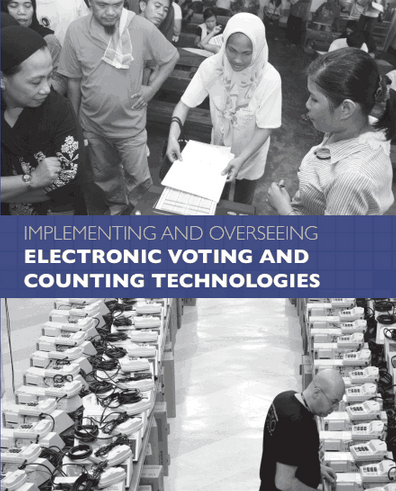How to Use this Manual
 This manual has been designed to provide a critical source of information on electronic voting and counting technologies for specialists in Democracy & Governance, as well as Election Management Bodies (EMBs), civil society organizations (CSOs), political parties and other key stakeholders engaged in electoral processes around the world. The manual provides a guide to the challenges, opportunities and considerations involved in decision-making, design and implementation of the technologies to assist EMBs as they move through the process or seek to understand it better, as well as to help other stakeholders, including civil society and electoral contestants, understand how to engage in and monitor these processes.
This manual has been designed to provide a critical source of information on electronic voting and counting technologies for specialists in Democracy & Governance, as well as Election Management Bodies (EMBs), civil society organizations (CSOs), political parties and other key stakeholders engaged in electoral processes around the world. The manual provides a guide to the challenges, opportunities and considerations involved in decision-making, design and implementation of the technologies to assist EMBs as they move through the process or seek to understand it better, as well as to help other stakeholders, including civil society and electoral contestants, understand how to engage in and monitor these processes.
IFES and NDI have designed the manual to provide both a brief primer as well as detailed exposition on the key issues related to electronic voting and counting. As such, the manual is adaptable for use by readers at different levels of engagement with these technologies. The guide below indicates how two different types of readers can use this manual.
For Readers Interested Only in a Brief Primer on Electronic Voting and Counting Technologies
The Overview chapter (Chapter 1) provides a brief introduction to the main issues involved in the effective design, implementation and oversight of these technologies. The chapter has been written to provide enough coverage of these issues so that the reader can gain a solid understanding of these issues without the need to read the detailed descriptions of each issue. For readers that would like to explore a particular issue or process in more depth, each issue covered in Chapter 1 has footnotes that guide the reader to specific subsections and page numbers of Chapter 2 that address the issue in more detail.
Chapter 2 addresses the key issues in much more depth by outlining in a chronological manner the processes of deciding on, designing, implementing and observing electronic voting or counting projects. While it is more detailed than Chapter 1, the general reader can still use two specific design elements of this chapter to quickly gain a general understanding of the most important points, as explained below.
Each of the key issues related to electronic voting and counting is addressed in subsections in Chapter 2. For each subsection, a summary of the discussion in this subsection is provided in brief text that is formatted as below:
Omnes detracto vis ut, vix ea ferri civibus. Nam te dicta habemus commune, quot nibh liber ad eam. Causae dissentiet cu sea, solum democritum repudiandae mea no. In purto fierent sit, vel facilisis salutatus te, et mucius veritus verterem sum.
Ea tamquam verterem ocurreret duo, inimicus dissentiet ad mea. Ne nullam vocent sea. Postulant sadipscing usu eu, cum reque veniam nonumes an. Ius omnes eloquentiam ei, mel erat adipisci consequat ne.
Additionally, at the end of each subsection, a list of key considerations is provided for both EMBs and oversight groups. This quick reference list can be used by EMBs, oversight groups, or a general audience to identify the questions that should be considered for the issue highlighted in the preceding subsection. The checklist is linked with a checkbox logo as seen here:
For Readers Interested in a More Detailed Understanding
Chapter 2 addresses each of the key issues related to electronic voting and counting technologies in much more depth than Chapter 1. Each of the key issues related to electronic voting and counting is addressed in sub-sections in Chapter 2.
For EMBs and oversight groups engaged in the implementation or oversight of these technologies, there is a checklist of important questions that should be considered by both EMBs and oversight groups for the issues addressed in each of the Chapter 2 subsections. EMBs and oversight groups can use these checklists to ensure that they are considering the significant aspects of each phase of the decisionmaking, design, implementation and evaluation of electronic voting and counting technology projects.
Chapter 2 also provides text boxes with brief case studies of how a particular issue related to electronic voting and counting technologies was addressed in practice. These case studies provide the reader with practical examples and lessons learned that can help inform their thinking on key issues.
Appendices 1 – 3 contain detailed cases studies on the use of electronic voting and/or counting technologies in the Philippines, Netherlands, and Brazil. These case studies provide descriptive narratives on how these countries addressed many of the issues detailed in the manual. These case studies also give the reader an appreciation of the challenges and complexity involved in the design, implementation and monitoring of e-voting and counting technologies, as well as the many lesson learned that have emerged from these three countries’ experiences.
Appendix 4 provides a list of additional resources on electronic voting and counting technologies.
